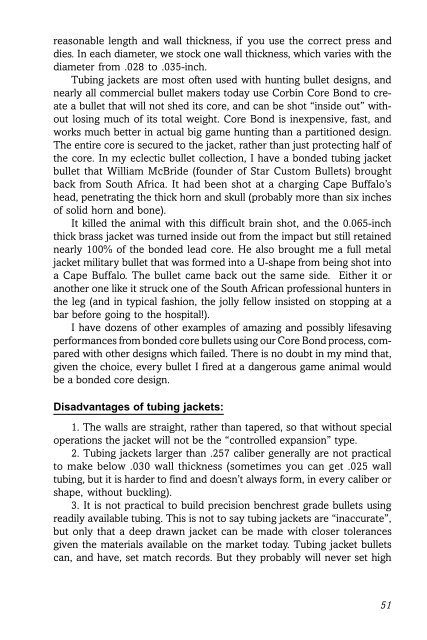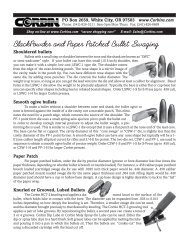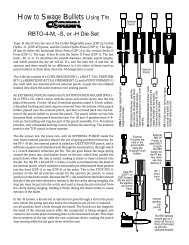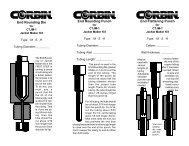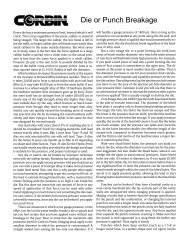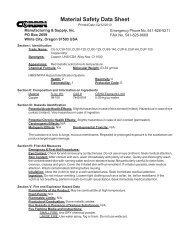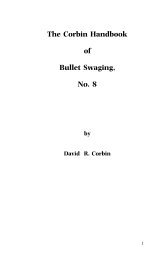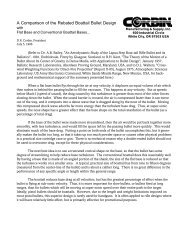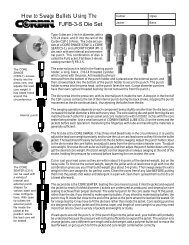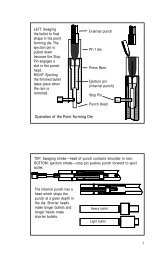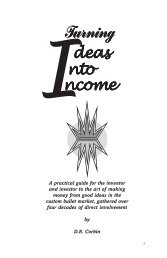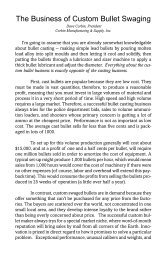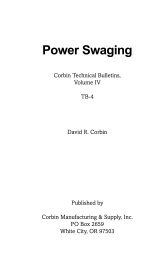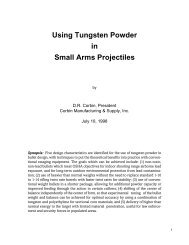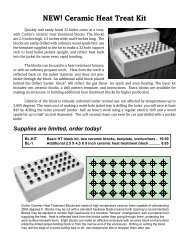HB-9 updated text (PDF) - Corbin Bullet Swaging
HB-9 updated text (PDF) - Corbin Bullet Swaging
HB-9 updated text (PDF) - Corbin Bullet Swaging
Create successful ePaper yourself
Turn your PDF publications into a flip-book with our unique Google optimized e-Paper software.
easonable length and wall thickness, if you use the correct press and<br />
dies. In each diameter, we stock one wall thickness, which varies with the<br />
diameter from .028 to .035-inch.<br />
Tubing jackets are most often used with hunting bullet designs, and<br />
nearly all commercial bullet makers today use <strong>Corbin</strong> Core Bond to create<br />
a bullet that will not shed its core, and can be shot “inside out” without<br />
losing much of its total weight. Core Bond is inexpensive, fast, and<br />
works much better in actual big game hunting than a partitioned design.<br />
The entire core is secured to the jacket, rather than just protecting half of<br />
the core. In my eclectic bullet collection, I have a bonded tubing jacket<br />
bullet that William McBride (founder of Star Custom <strong>Bullet</strong>s) brought<br />
back from South Africa. It had been shot at a charging Cape Buffalo’s<br />
head, penetrating the thick horn and skull (probably more than six inches<br />
of solid horn and bone).<br />
It killed the animal with this difficult brain shot, and the 0.065-inch<br />
thick brass jacket was turned inside out from the impact but still retained<br />
nearly 100% of the bonded lead core. He also brought me a full metal<br />
jacket military bullet that was formed into a U-shape from being shot into<br />
a Cape Buffalo. The bullet came back out the same side. Either it or<br />
another one like it struck one of the South African professional hunters in<br />
the leg (and in typical fashion, the jolly fellow insisted on stopping at a<br />
bar before going to the hospital!).<br />
I have dozens of other examples of amazing and possibly lifesaving<br />
performances from bonded core bullets using our Core Bond process, compared<br />
with other designs which failed. There is no doubt in my mind that,<br />
given the choice, every bullet I fired at a dangerous game animal would<br />
be a bonded core design.<br />
Disadvantages of tubing jackets:<br />
1. The walls are straight, rather than tapered, so that without special<br />
operations the jacket will not be the “controlled expansion” type.<br />
2. Tubing jackets larger than .257 caliber generally are not practical<br />
to make below .030 wall thickness (sometimes you can get .025 wall<br />
tubing, but it is harder to find and doesn’t always form, in every caliber or<br />
shape, without buckling).<br />
3. It is not practical to build precision benchrest grade bullets using<br />
readily available tubing. This is not to say tubing jackets are “inaccurate”,<br />
but only that a deep drawn jacket can be made with closer tolerances<br />
given the materials available on the market today. Tubing jacket bullets<br />
can, and have, set match records. But they probably will never set high<br />
51


